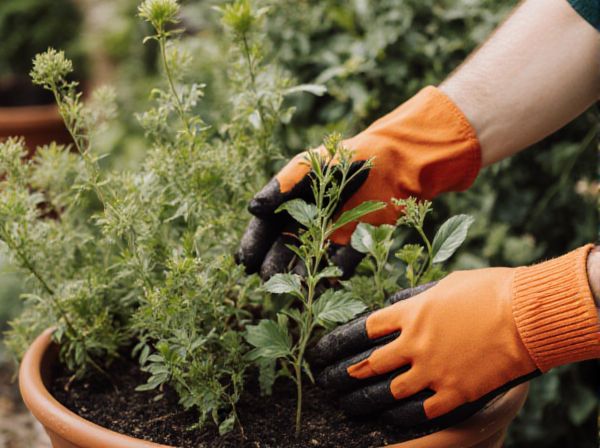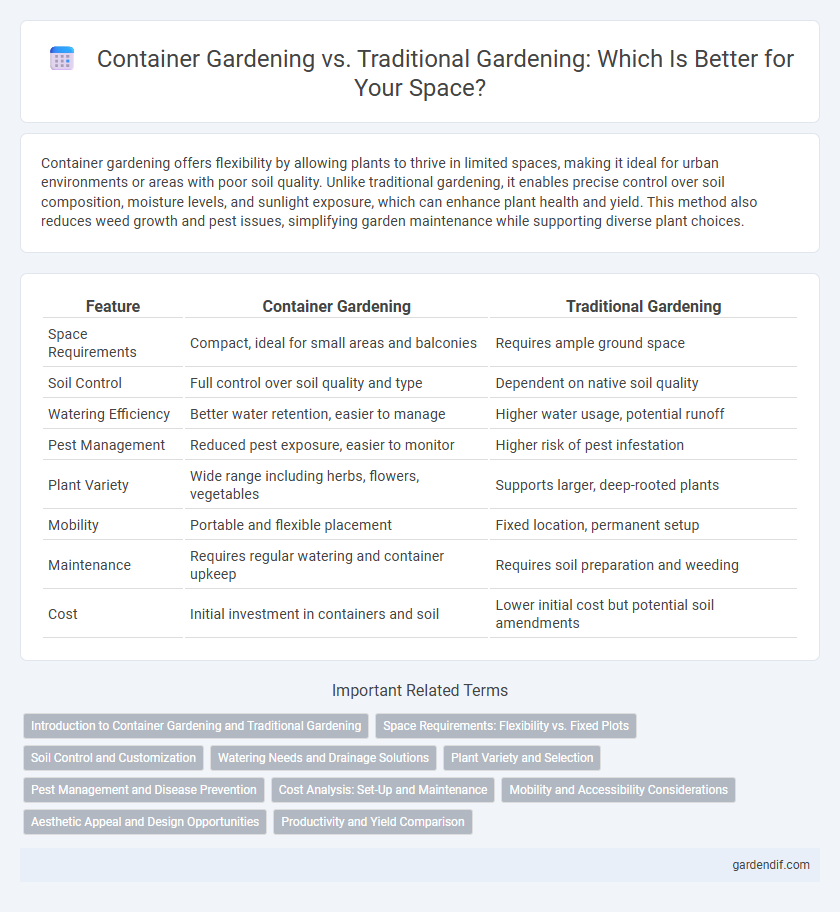
Container gardening vs traditional gardening Illustration
Container gardening offers flexibility by allowing plants to thrive in limited spaces, making it ideal for urban environments or areas with poor soil quality. Unlike traditional gardening, it enables precise control over soil composition, moisture levels, and sunlight exposure, which can enhance plant health and yield. This method also reduces weed growth and pest issues, simplifying garden maintenance while supporting diverse plant choices.
Table of Comparison
| Feature | Container Gardening | Traditional Gardening |
|---|---|---|
| Space Requirements | Compact, ideal for small areas and balconies | Requires ample ground space |
| Soil Control | Full control over soil quality and type | Dependent on native soil quality |
| Watering Efficiency | Better water retention, easier to manage | Higher water usage, potential runoff |
| Pest Management | Reduced pest exposure, easier to monitor | Higher risk of pest infestation |
| Plant Variety | Wide range including herbs, flowers, vegetables | Supports larger, deep-rooted plants |
| Mobility | Portable and flexible placement | Fixed location, permanent setup |
| Maintenance | Requires regular watering and container upkeep | Requires soil preparation and weeding |
| Cost | Initial investment in containers and soil | Lower initial cost but potential soil amendments |
Introduction to Container Gardening and Traditional Gardening
Container gardening involves growing plants in pots, containers, or other confined spaces, offering flexibility and control over soil quality, drainage, and plant placement. Traditional gardening typically uses in-ground beds or open soil, providing plants with natural root expansion and access to native soil nutrients. Both methods offer unique benefits, with container gardening ideal for small spaces and urban environments, while traditional gardening supports larger-scale cultivation and biodiversity.
Space Requirements: Flexibility vs. Fixed Plots
Container gardening offers unparalleled flexibility in space utilization, allowing plants to be grown on balconies, patios, or small urban areas without the need for fixed plots. Traditional gardening demands larger, dedicated land areas, which can limit planting options in space-constrained environments. The adaptability of container gardening suits diverse spatial constraints, making it ideal for maximizing green space in limited or unconventional locations.
Soil Control and Customization
Container gardening offers superior soil control by allowing gardeners to select and tailor soil mixes specifically suited to each plant's needs, preventing issues like soil compaction and poor drainage common in traditional gardening. The customization in container gardening extends to precise nutrient management and pH adjustment, optimizing growth conditions that traditional in-ground methods may lack due to variable natural soil composition. These advantages make container gardening ideal for urban environments and limited spaces where soil quality and consistency are challenging to maintain.
Watering Needs and Drainage Solutions
Container gardening requires precise watering schedules due to limited soil volume, preventing both under- and over-watering that can stress plants. Proper drainage solutions such as built-in holes and layering with gravel or activated charcoal ensure excess water escapes, reducing root rot risks common in containers. Traditional gardening relies on natural soil absorption and drainage, often needing less frequent watering and artificial drainage interventions.
Plant Variety and Selection
Container gardening offers greater flexibility in plant variety and selection, allowing gardeners to grow diverse species regardless of soil quality or climate constraints. Traditional gardening often limits choices to native or climate-adapted plants, while containers enable cultivation of exotic or delicate varieties through controlled soil and micro-environments. This adaptability in container gardening enhances biodiversity and enables seasonal rotation to optimize plant health and yield.
Pest Management and Disease Prevention
Container gardening offers enhanced pest management by isolating plants, reducing the spread of diseases common in traditional gardening soil beds. Controlled soil quality and drainage in containers minimize fungal infections and root rot, key concerns in open-ground gardening. Regular monitoring and easy application of targeted treatments in confined spaces make pest control more efficient compared to traditional garden setups.
Cost Analysis: Set-Up and Maintenance
Container gardening typically requires lower initial investment than traditional gardening due to reduced need for soil preparation, tools, and space. Maintenance costs in container gardening are often higher, reflecting frequent watering, specialized potting mix, and potential container replacement. Traditional gardening incurs higher setup costs with soil amendment and land preparation but benefits from lower ongoing expenses through natural soil fertility and less frequent watering.
Mobility and Accessibility Considerations
Container gardening offers superior mobility compared to traditional gardening, allowing plants to be moved easily to optimize sunlight exposure and protect against harsh weather conditions. This flexibility enhances accessibility for individuals with limited mobility, as containers can be placed at ergonomic heights, reducing the need for bending or kneeling. Traditional gardening often lacks this adaptability, making container gardening ideal for urban environments and small spaces where ease of access and plant relocation are crucial.
Aesthetic Appeal and Design Opportunities
Container gardening offers unparalleled aesthetic appeal by allowing gardeners to create visually striking arrangements with a variety of shapes, colors, and textures in confined spaces. Unlike traditional gardening, which is limited to ground plots, container gardening enables dynamic design opportunities such as vertical stacking, seasonal rotation, and the use of decorative pots that complement architectural styles. This flexibility enhances urban environments and small balconies, transforming them into personalized green oases with tailored visual interest.
Productivity and Yield Comparison
Container gardening often results in higher productivity per square foot compared to traditional gardening due to controlled soil quality and optimal space utilization. Plants grown in containers benefit from better drainage and targeted nutrient delivery, which can enhance yields and reduce disease risks. Traditional gardening may produce larger overall harvests but requires more land and is more susceptible to environmental variability affecting crop yield consistency.
Container gardening vs traditional gardening Infographic

 gardendif.com
gardendif.com